QUESTIONS
SECTION A ( 25 MARKS)
- The figure shows a section of vanier clipers when the jaws are closed withuot an object between them.

- State the zero error on the vanier calipers. 1mk
- A student used the vanier shown to measure the diameter of a test tube whose actual diameter was 2.2cm .determine the reading of the calipers of the test tube.
-
- a student observed that when the lower end of a verticalclean glass capillary tube was just immersed in water, the water rose up the tube. Explain the observation. 1mk.
- bristles of a paint brush spread when the brush is in the water and cling together when out of weter. Explain. 2mks
-
- a mixture of air was illuminated and viewed through a microscope in a glass sided box. Small bright specks were seen to be moving randomly . explain this observation. 2mks.
- when the stopper of a bottle containing liQUID ammonia is removed, the gas is smelt allover the room. Explain (1mks)
-
- State two assumptions made when determining the diameter of a molecule in the oil drop experiment. (2mks)
- State one application of Bournoullis effect (1mks)
- The figure below shows a silvery shinny surface electric kettle being used to heat water from a main supply.
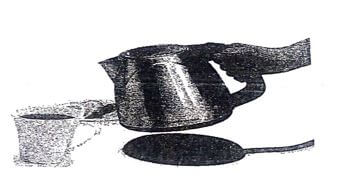
Explain two features of the kettle which enhances its efficiency (2mks) - A uniform plank weighing 300N and lengh 6.0m is acted upon by other forces as shown in the figure below.

Calculate the tension T in the string and the reaction R at the pivot. (3mks) - A faulty thermometer reads 5ºC when placed in pure melting ice and 20ºC when placed in water at a temperature of 25ºC. What is the actual temperature when this thermometer reads 78ºC. (3mks)
-
- The height of a mountain is 1360m. The barometer reading at the base of the mountain is 740mmHg. Given that the density of mercury is 13.6g/cm3 and that of air is 1.25Kg/M3, determine the barometer reading at the top of the mountain? (3mks)
- Two home economics students were cooking,one on top of a high mountain and the other down in a valley. State and explain which of the two students should use a pressure cooker for faster cooking? (2mks)
Section B (55mks)
-
- During the construction of dam of thye dam is widened and curved. Explain. (2mks)
- A block of density 1.58g/cm3 and measures 3cm by 5cm by 7cm was placed on the ground. Determine the difference between the maximum and minimum pressure that would be exerted on the ground by the block (3mks)
-
- The figure below shows a ball of mass 50Kg thrown from the top of a wall 20m high with a horizontal velocity 20m/s. The ball strikes the smaller piston A of the hydraulic lift and compresses a cotton bail B with a 25200N force.
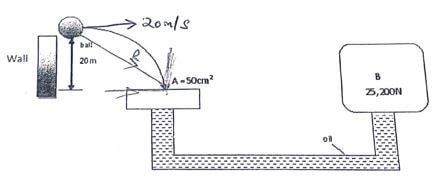
Determine;- The time taken by the ball to hit the piston A (2mks)
- The horizontal distance covered by the ball from the foot of the wall to the piston (2mks)
- The vertical velocity with which the ball hits the piston A (2mks)
- The force with which the ball strikes piston A (Assume the ball hits the piston verically) (2mks)
- The area of the load piston B asuming that the two pistons were initially at the same level. (2mks)
-
- State Hookes law (2mks)
- A string extends by 5cm when supporting a load of 10N. Determine the spring constant of 3 such springs when placed side by sides. (2mks)
- What is the extension of the three springs in part ii above when supporting a load of 50N? (2mks)
- The figure below shows a ball of mass 50Kg thrown from the top of a wall 20m high with a horizontal velocity 20m/s. The ball strikes the smaller piston A of the hydraulic lift and compresses a cotton bail B with a 25200N force.
-
- Give a reason why a steel rod sinks in water while a ship made of steel floats on water. (1mks)
- The figure below show a bouy B of volume 40 litres and mass 10Kg. It is held in the position shown below in sea water of density 1.04g/cm3 by a light inextensible cable at the bottom so that ¾ of its volume is submerged below the surface of the sea water.
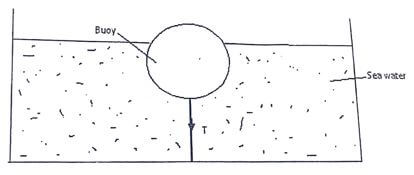
Determine the tension in the cable (3mks) - State a factor which detrmines a depth to which a body sinks in a liquid (1mks)
- A student constructed a hydometer for use in the milk industry. What is the name given to this hydrometer ? (1mks)
- The apparatus below was used to investigate the variation of presuure of a trapped sample of air with temperature.
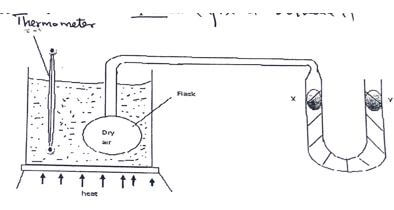
- Why must the heat be supplied slowly during the experiment? (1mks)
- How would you ensure that the air trapped in the flask was at the temperature recoreded by the thermometer ? (2mks)
- Why the U tube is always adjusted so that the level of mercury in the tube X stays the same (1mks)
- What measurements would be recorded in the experiment above ? (2mks)
- During an experiment a 30g metal block was heated in a blast furnace to a temperature of 850ºC. Then quickly transferred to a copper calorimeter of mass 200g containing 60g of water at 80ºC. It was observed that 20g of water vapourized. Given that the specific heat capacity of water and that of copper are 4.2kJ/Kg/K and 390J/Kg/K respecively, and the specific latent heat of vapourisation of steam is 2.26×106J/Kg.
- Write an expression for the heat lost by the meatl block given that the specific heat capacity is Cm. (2mks)
- Determine the heat gained by the water anf the calorimeter (3mks)
- Calculate the specific heat capacity of the metal (3mks)
- State on possible source of error in the experiment (1mks)
-
- Explain why a motorist rider leans towards the centre of the curve while negotiating a bend (1mks)
- In an experiment to determine the tension of a string, a solid ball was roatate round a turn table of diameter 80cm at different velocities. The tension T at different values of velocity squared was obtained and the results represented on a graph shown below.
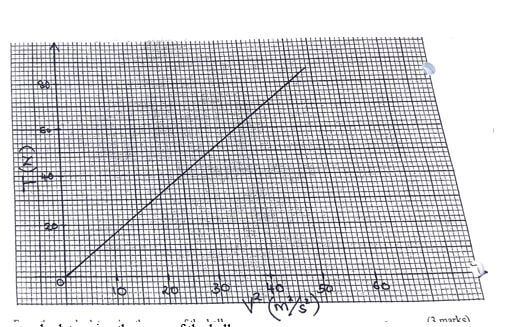
From the graph, determine the mass of the ball
- the diagram below shows a pulley system with a load of 20N hung at the lower block. The effort consists of a pan on which weights are added one at a time.
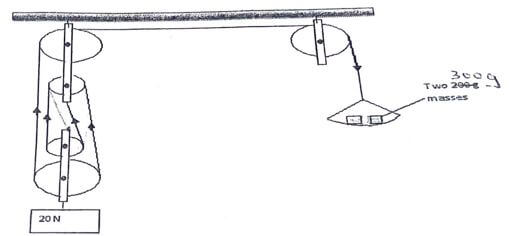
Determine;- The velocity ratio of the machine (1mks)
- The mechanical advantage if the two 200g masses coul cause the 20N load to raise steadily (2mks)
- The efficiency of the system (2mks)
- When the load was increased, it was observed that the efficiency assumed the trend shown in graph below
State and explain results obtained (2mks) - A body of mass 0.6Kg is whirled in a vertical circle of radius 60cm as shown in the diagram below
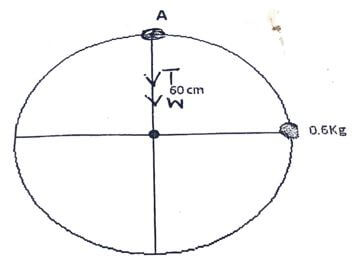
If the tensionin the string at the highest point A is 19N, determine the minimum velocity needed to keep the body in a circular path (2mks)
MARKING SCHEME
-
- +0.03 cm
- actual = reading - zero error
diametre = reading - 0.03
reading = 2.20 + 0.03
= 2.23 cm
-
- the force of adhesion is greater than the force of cohesion
- paint brush spread since surface tension does not exist inside but they cling together because of surface tension which tends to make surface area as smooth as possible
-
- This is due to uneven bordbardment of the smoke particles by the unseen air molecules which are also in constant random motion
- This is because of diffucion, pesticides of ammonia spread from the region of high concentration to those of low concentration.
-
- the fluid is incomprehensible
the fluid is non-viscous
the flow is streamline - The aerofoil
the bunsen burner
the spray gun
the carburettor
flow meters
- the fluid is incomprehensible
- the kettle is silvery shiny surface , to minimise heat losses by radiation
The heating coil is placed of the bottom utilize coordinational currents when heating
Lid / stopper - minimize heat loss by evaporation and condensation - 2 x 300 + 3 x 100 = 4T
600 + 300 = 4T
T = 900/4 = 225N
R + T = 400
R = 400 - 225 = 175 N - 25 - 0 = θ - 0
20 - 5 78 - 5
θ = 25/15 x 73 = 121.67ºC -
- Δp = 1360 x 1.25 x 10 = 17000 Pa
(0.740 - x) x 13600 x 10 = 17000
(0.740 - x) = 0.125
x = 0.740 - 125 = 0.615m = 61.5 cm HG - students at the top of the mountain
Low pressure at the top of the mountain hence water boils at a lower temperature
- Δp = 1360 x 1.25 x 10 = 17000 Pa
-
- widened - the withstand the pressure and the bottom. The walls are made strong
curved - so that the slanting walls are used to support the weight of the water - Pmax = 0.07 x 1580 x 10 = 1106Pa
Pmin = 0.03 x 1580 x 10 = 474Pa
Pmax - Pmin = 1106 - 474 = 632 Pa
- widened - the withstand the pressure and the bottom. The walls are made strong
-
-
- h = 1/2gt2 = 5t2
20 = 5t2
t2 = 4
t = √4 = 2 seconds - Range = U x t
20 x 2
= 40 m - V = gt
10 x 2
= 20 m/s - ans = v = √800 = 28.2842712475
- A2 = 2,520 cm2
- h = 1/2gt2 = 5t2
-
- for an elastic material or spring extension is directly proportional to the stretching force provided the elastic limit is not exceded
- K = 3 x 2
= 6 N/o - F = k.e
e = 50/66.67
= 0.75m
e = f/k = 50/6 = 8.333 cm
-
-
- The rod sinks because of small volume and larger mass its density is greater than that of the water
The steelship is hollow such that its effective
The density is less than that of water - u = 3/4 x 40 x 10-3 x 1040 x 10
= 312 N
W = 10 x 10 = 100N
u = W + T
T = 312 - 100 = 212 N 
h = w
ASLG- lactometer
- The rod sinks because of small volume and larger mass its density is greater than that of the water
-
- so that the dry air attains the uniform temperature of the bath
- Heat slowly and stir continuously
Remove the heat take the reading when the thermometer has stopped rising
Submerge the bulb / flask vender water - To keep the volume of trapped air constant throughout the experiment
- Temperature θ
pressure P
-
- Q = 30 x 10-3 x Cm x (850 - 100)
= 22.5Cm J - Qgained = 60 x 4.2 x 20 + 200 x 0.390 x 20 + 20 x 2.26 + 103
= 5040 + 1560 + 451200
= 660J = 51,800J - 22.5 cm = 6600 + 20 x 2260
= 6600 + 45400
= 51800
Cm = 51800/22.5 = 2302.2 J Kg-1 K-1 - Heat losses to the surroundings
- Q = 30 x 10-3 x Cm x (850 - 100)
-
- leaning increases centripetal force (part of reaction force component)
Hence, it increases the critical speed 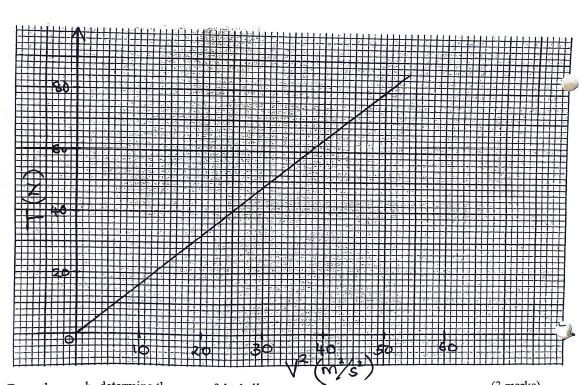
= 0.25 Kg
- leaning increases centripetal force (part of reaction force component)
-
- V.R = 4
- M.A = 20/6
= 3.3333 - ? = M.A/V.R x 100
= 20/6 x 1/4 x 100
= 83.33% 
As the load increased the useless weight become neglible in comparison to the larger load, hence efficiency is increased.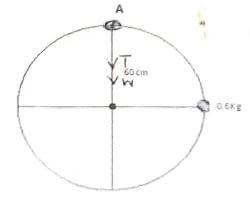
T + W = Fc
Fc = 19 + 6
25N = Mu2
8
V2 = 25 x 0.6 = 25
0.6
v = √25 = 5m/s
Join our whatsapp group for latest updates
Tap Here to Download for 50/-
Get on WhatsApp for 50/-
Download Physics Paper 1 Questions and Answers - Form 4 Term 2 Opener Exams 2023.
Tap Here to Download for 50/-
Get on WhatsApp for 50/-
Why download?
- ✔ To read offline at any time.
- ✔ To Print at your convenience
- ✔ Share Easily with Friends / Students

